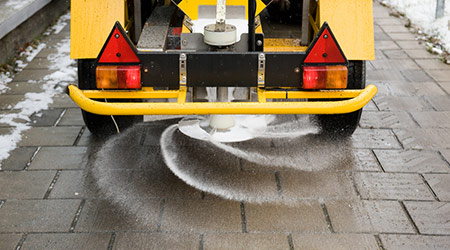One way to cut the amount of salt used is by spreading salt brine before the storm hits, rather than waiting until the snow is on the ground and trying to melt it with rock salt, according to an article from Building Operation Management on the FacilitiesNet website.
The idea is to “get away from de-icing and toward anti-icing,” said Daniel Gilleland, training manager with SnowEx, adding that an application of brine can reduce the amount of chloride needed to melt snow on a parking lot by about 90 percent.
The salt itself doesn’t melt anything; rather, it has to turn to brine in order to work, Gilleland said. “When you apply rock salt, it sits there for some length of time before it turns to brine,” he says. Applying salt as brine accelerates this process.
Moreover, the brine can be applied in advance, as it doesn’t wear off. Instead, it “just dries, and waits for the moisture to come,” Gilleland said. Many departments of transportation apply brine to bridges and steep inclines ahead of storms, to head off slipperiness.
Michigan State University, for instance, uses a liquid de-icer derived from beet juice to melt snow on roads and walkways. According to the university, “the organic de-icer is also more effective under colder weather conditions than traditional salt because it melts the snow and ice at lower temperatures.”

 How Efficiency Checklists Help Hospitals Save Energy, Water and Money
How Efficiency Checklists Help Hospitals Save Energy, Water and Money Designing with Heart: Seen Health Center Blends Cultural Warmth and Clinical Care
Designing with Heart: Seen Health Center Blends Cultural Warmth and Clinical Care Rutgers Health and University Hospital Breaks Ground on Campus Expansion
Rutgers Health and University Hospital Breaks Ground on Campus Expansion What to Consider When Modernizing Healthcare Facilities
What to Consider When Modernizing Healthcare Facilities Corewell Health Beaumont Troy Hospital to Build New Tower
Corewell Health Beaumont Troy Hospital to Build New Tower